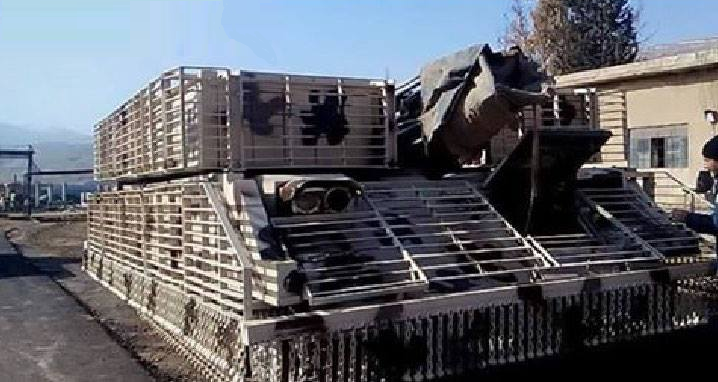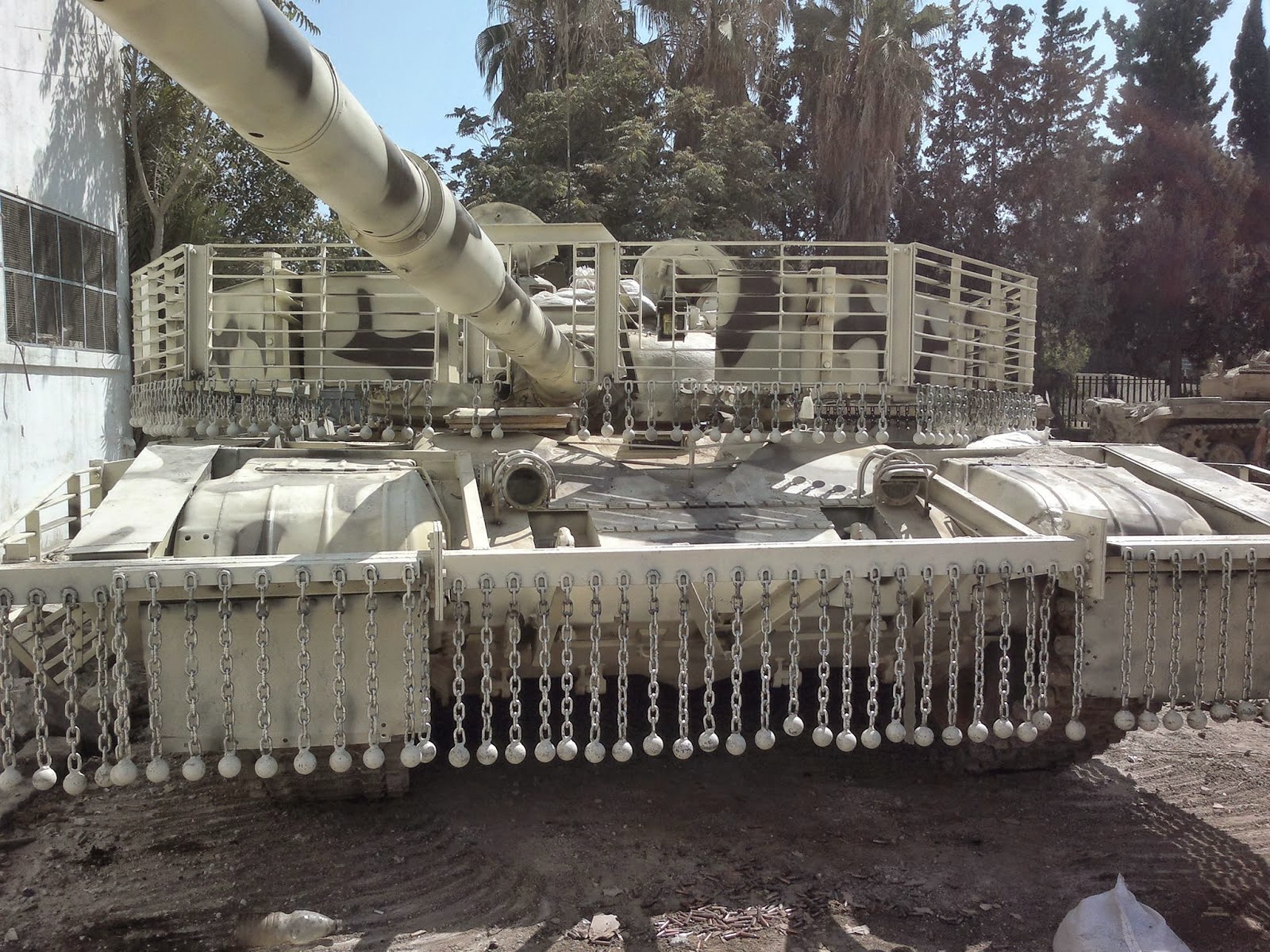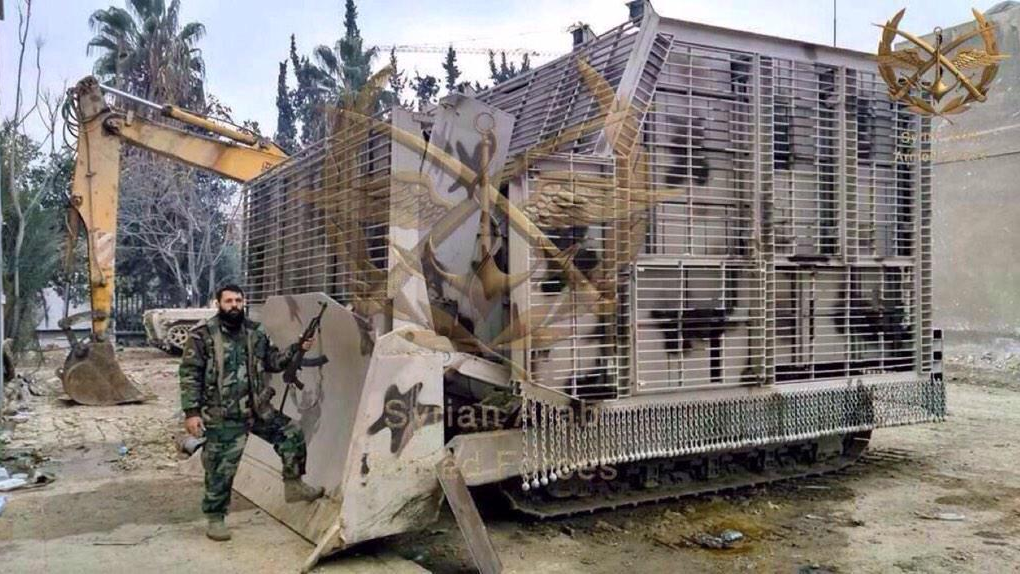Following local experiments with spaced and slat armour on T-72AVs and BMP-2s, the Republican Guard initiated a small-scale upgrade programme for its armour in the summer of 2014. After upgrading several of its T-72M1s and bulldozers with additional armour, the Republican Guard is now also operating at least one ZSU-23-4 self-propelled anti-aircraft gun (SPAAG) upgraded in the same fashion.
The goal of the upgrade programme was to increase the chances of survivability of armoured fighting vehicles by adding additional armour, which consists of spaced and slat armour, further reinforced by metal chaines. Altogether, it provides an impressive 360 degree coverage against regular RPGs.Heavier RPGs like the RPG-29, the M79 Osa or later generation RPG-7 warheads have less trouble penetrating such armour however.
The first vehicles upgraded as part of this programme were several T-72M1s, which were then deployed to Jobar in order to test the actual combat value of the new armour package. These first missions did not end well as one of the upgraded T-72M1s got stuck and was subsequently abandoned by its crew, while another was completely destroyed after entering Jobar: a tragic start for the ambitious programme.[1][2]
This however did not deter the Republican Guard from pressing on with the upgrade programme, and several upgraded T-72M1s continued to join units in Jobar, Eastern Ghouta and even Aleppo in the months that followed. The factory responsible for the programme is located in Adra, north of Damascus.

A similar armour package, developed and produced by the same factory, was applied on bulldozers in use by the Republican Guard.
The bulldozer earned its position in most of the offensives taking place in the neighbourhoods of Damascus and Eastern Ghouta where they're used to transport soldiers to the frontline, clear obstacles, raise sand barriers to cover infantry and tanks and clear suspected minefields. When they were still operating without these armour packages, they were an easy prey for the rebels' anti-tank teams, anti-materiel rifles and even machine gun fire, even when equipped with locally applied DIY armour.
Apart from small factory differences or minor field modifications, two variations are known to exist. These variations give a clear indication of how the designs and production of these armour packages have progressed over time.
The example below was active in Jobar, where it was mainly used to transport troops and clear minefields. It was destroyed in late December 2014 after being caught in the open by fighters of Failaq al-Rahman, also known as the Rahman corps, while supposedly trying to clear a minefield.
The bulldozer was only immobilized after receiving multiple hits from an RPG-7 and being fired upon by an anti-materiel rifle. Failaq al-Rahman then dug a tunnel to the abandoned bulldozer, and placed a satchel charge underneath it to prevent the recovery of the vehicle. The subsequent explosion breached its hull and started a fire, rendering it useless for future use.[3][4]

The next vehicle to receive the armour upgrade was the ZSU-23-4. Combat experience gained in Darayya showed the need for a vehicle capable of engaging high-located rebel positions in flats and apartments, almost always out of reach of the T-72s.
Following the lead of several other nations in the past, Syria began to use its large fleet of ZSU-23-4s to support tanks and infantry. The biggest weakness of the ZSU-23-4 in this role is its weak armour. Originally designed to engage aircraft and helicopters while operating behind tanks and infantry fighting vehicles (IFVs) on the plains of Europe, the armour of the vehicle is anything but well suited for engaging enemy hideouts from up close. The recent capture of Brigade 82 near Sheikh Miskin serves as a heavy-handed reminder of this fact.[5]
The installation of the armour package will largely address the ZSU-23-4's vulnerability to a range of small arms and RPGs, and will allow the vehicle to provide fire-support closer to the battle than before. With its extremely high rate of fire, large calibre and a range of elevation that covers any potential target, it is the ideal city conquest support vehicle made perfect; a warmachine completely adapted to the hostile environment that has made up the Syrian battlefield for close to four years.

After the metal chaines on the front of the T-72M1s proved to be incapable of stopping RPGs, most of the upgraded T-72M1s saw their metal chaines replaced by additional spaced armour or simply a piece of metal. These conversions were done in the T-72's operational area, as the factory responsible for the armour packages strangely enough still produces them with metal chains on front of the T-72.
Since the active conflict provides a myriad of combat reports on weaknesses and strenths of various types of equipment, it is likely subsequent variants of the upgraded armour will address these issues and thus become increasingly effective.
The combat value of the armour package was believed to be minimal after two of the upgraded T-72M1s were destroyed in Jobar. This however is in no way representative of the actual combat performance of the new armour. It is possible that the new armour package gave crews a feeling of invincibility, leading to the crews taking larger risks than normal and thus resulting in their vehicles being destroyed. One image from Eastern Ghouta confirms its effectiveness in combat however, showing one upgraded T-72M1s still intact after receiving several hits from an RPG.
While it is clear that single instances of the new armour pitted against unknown types of anti-tank weaponry hardly make a case for the up- and downsides of the armour package, it is obvious the Republican Guarddeems it effective enough to allocate significant resources to it.
The upgrades performed on these vehicles prove the Syrian Arab Army and Republican Guard are not running out of steam just yet. Although the installation of this armour package is impossible on T-72 'Urals' due to the location of its rangefinder, it is expected more and more armoured fighting vehicles will be upgraded in the same way. The Republican Guard's BMP-2s may very well be next in line.
Recommended Articles
Onwards to the front, Syria's BMPs
Syria's Steel Beasts: The T-55
Syria's Steel Beasts: The T-62
Syria's Steel Beasts: The T-72

























